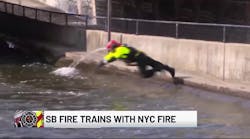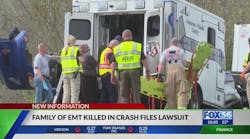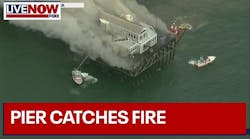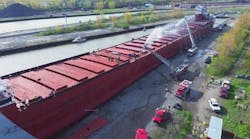Search and rescue is the one function that should always be considered first when responding to an emergency. In most cases, there is no need to conduct a search or make a rescue.
Downloadable Instructor's Guides
Session Reference:
Topic: Back To Basics: Structural Search And Rescue
Time Required: 3 Hours
Materials:
- Self Contained Breathing Apparatus
- Personal Protective Clothing
- Area to Conduct Small & Large Area Searches
References:
- Essentials of Fire Fighting, Fourth Edition, IFSTA, Chapters 7, Pages 175-186
Preparation:
Motivation: Search and rescue is the one function that should always be considered first when responding to an emergency. In most cases, there is no need to conduct a search or make a rescue. However, when there is an obvious rescue, it is important that the search team locate the victim and remove them to safety as quickly as possible. Proper search techniques can improve operating efficiency.
Objective (SPO): The student will demonstrate a basic understanding of search and rescue operations and consideration and search techniques and victim removal.
Overview: Back To Basics: Structural Search And Rescue
- Search
- Rescue
- Search and Rescue Practical
Instructors Notes: The purpose of this drill is to review and build on basic skills with the emphasis on improving efficiency and teamwork. It is assumed that the participants have some basic knowledge of the subject matter. The focus of the drill should include personal and team safety. The drill should include minimal instruction and maximum skills practice. The drill should also be conducted with the normal staffing that would respond on an engine, truck, or rescue squad on a structure assignment.
Back To Basics: Structural Search And Rescue
SPO 1-1 The student will demonstrate a basic understanding of search and rescue operations and consideration and search techniques and victim removal.EO 1-1
Explain the considerations related to conducting a search in various situations.
EO 1-2
Explain the considerations related to rescuing a victim from various situations.
EO 1-3
Demonstrate the proper techniques for conducting a search of a small and large area and removal of victims by drags or carries.
Instructional Guide
- SEARCH (1-1)
- Clues for need to search
- Time of day
- Type of occupancy
- Vehicles in driveway or on the street in front of the structure
- Playthings in the yard
- Lights on in the structure
- Information from neighbors or occupants who have escaped
- Alarm called in from someone other than an occupant
- Sounds or sights of victims trapped or needing rescued
- Information from the dispatcher
NOTE: NFPA 1500 and 29 CFR 1910.134 require that a rescue team be in place outside before any interior operations begin unless there is an obvious rescue (two-in/two-out rule). Most of the clues above indicate there may be a potential for a rescue and should not be construed to be obvious signs of a rescue. The most obvious signs are seeing or hearing the victims or credible information that someone is trapped (victim may have escaped without the knowledge of rescuers or the Incident Command). Be aware that conducting a search is one of the most dangerous activities on the emergency scene. We should not be risking the lives of firefighters for a victim recovery nor should we be trading lives during very risky rescues.
- Type of searches
- Primary search
- Done immediately upon arrival at the scene (may be initiated prior to the advancement of attack lines)
- Done in teams of at least two firefighters
- Done systematically and quickly
- Done in conjunction with locating the search of the fire
- May be done in conjunction with localized ventilation
- Secondary search
- Undertaken by a different team to minimize victims being overlooked
- Done after the primary search of a particular area is completed
- Done in a systematic manner
- May be slower and more thorough
- General search guidelines
- Team members must maintain visual or voice contact with each other throughout the operation
- Search the area of the fire and adjacent areas first
- Search the floor above the fire second
- Search the highest point directly above the fire third
- Search other areas as time and resources permit
- Close doors to slow down the spread of fire
- Perform local ventilation as needed to improve conditions for the victim
- Mark the entrance to the area being searched
- Always turn the same direction when searching
- Stay in contact with a wall to prevent loss of direction
- Consider using a search rope to prevent loss of direction
- Consider using a thermal imaging camera to help locate victims
- Stay low but check upper areas for victims
- Check under, behind, and on top of objects
- Check locations such as closets and bathrooms
- Use tools or rope or webbing to extend reach
- Consider using a piece of rope or webbing to assist in victim removal
- Keep unnecessary noise to a minimum and look and listen for victims
- Mark the area after the search has been completed using furniture or any other means
- May require a hoseline to protect the escape route or separate the fire from the victim
- Try to have a secondary means of escape
- Be on the lookout for unsafe structural conditions or hazardous contents
- Advise command of anything found
- Small area search - residential or commercial with individual offices
- Carry necessary tools (entry tools, handlight, radio, search rope or webbing, etc.)
- Check door with back of hand before entering to determine if fire is on the other side
- If door opens in, stay to side away from door opening to avoid fire and heat (put rope or webbing on doorknob in case the door needs to be pulled closed)
- If door opens out, stay behind door to avoid fire and heat (use a foot to stop the door from opening further than desired)
- Stay low and open door slowly
- Search in teams of at least two with team members staying in visual or voice contact with each other
- If the smoke is light (firefighters can see their toes) the search can be conducted while walking, otherwise crawl on hands and knees
- One firefighter should maintain contact with the wall while searching the perimeter of the room if both firefighters are staying together
- If the two firefighters split, both firefighters should maintain contact with the wall while searching the middle area of the room
- Tools can be used to probe areas
- Be sure to stay low if crawling but search upper areas especially the surfaces of beds, couches, and chairs
- Use a handlight to extend visual reach
- Once the two firefighters have met or reached the entrance point, there may be a need to search the middle area if this has not already been searched
- Once the room has been searched, close the door and mark it to indicate that the primary or secondary search has been completed
- Move from room to room until the entire structure has been searched
- Larger structures may require multiple search teams
- If the building being searched is an apartment building with a common corridor, teams may be assigned to each side of the hallway
- If there are rooms running off the room being searched, mark the point of departure from the initial search so that the initial search can be resumed after the other room or rooms have been searched
- Once the search has been completed, advise the Command Post of the results
- Large area search - retail, warehouse, large open space
- Search area will require multiple teams
- Carry necessary tools (entry tools, handlight, radio, search rope or webbing, etc.)
- Check door with back of hand before entering to determine if fire is on the other side
- If door opens in, stay to side away from door opening to avoid fire and heat (put rope or webbing on door handle in case the door needs to be pulled closed)
- If door opens out, stay behind door to avoid fire and heat
- Stay low and open door slowly
- Each search team member must stay in visual or voice contact with other members of their search team
- If the smoke is light (firefighters can see their toes) the search can be conducted while walking, otherwise crawl on hands and knees
- Mark the entrance or attach a search rope to reduce loss of direction (may be a long rope with markings for rope length and connections to allow shorter ropes to be attached for searching while maintaining contact with the search rope)
- One firefighter should maintain contact with the wall while the other firefighter is searching the inner area if a search rope is not being used
- Tools can be used to probe areas
- Be sure to stay low if crawling but search upper areas
- Use a handlight to extend visual reach
- Be aware of the need to search around obstacles such as shelves, merchandise, etc.
- Once the teams have met or reached the entrance point, there may be a need to search the middle area if this has not already been done
- Once the area has been searched, close the door and mark it to indicate that the primary or secondary search has been completed
- Move from area to area until the entire structure has been searched
- If the building being searched has a common corridor, teams may be assigned to each side of the hallway
- If there are areas running off the area being searched, mark the point of departure from the initial search so that the initial search can be resumed after the other area has been searched
- Once the search has been completed, advise the Command Post of the results
- Missing firefighter
- Attempt to determine the LUNAR (location, unit number, name or names, assignment, and resources needed) if advised of the missing firefighter(s) by radio
- Listen for a PASS device
- Following a hoseline may help to isolate the search area (firefighters may be near the hoseline)
- Consider activating pagers
- Consider placing two radios against each other to create squelch when the transmit button is depressed
- Stop periodically to listen for calls for help
- Look near windows or doors
- Look for visual signs at windows (personnel at the window, equipment or clothing hanging out the window, etc.)
- Look for areas of collapse or possible entrapment
- Attempt to retrace to the last known location
- Emergency rescue conditions requiring immediate rescue
- Fire or danger of fire in the immediate area
- Explosives or other hazardous materials involved
- Impossible to protect the scene
- Impossible to gain access to other victims who need immediate lifesaving care
- Victim is in cardiac arrest and must be moved to a different area so that CPR can be administered
- General guidelines
- Use lifts and carries when there is little or no smoke present
- When dragging, move the victim in the long axis of the body to reduce potential spinal damage
- If the victim is on the floor, consider pulling on clothing in the neck or shoulder area
- Consider using a blanket or similar material to drag the victim
- Teamwork and communications are important to victim removal
- Lifts and carries
- Cradle-in-arms lift/carry - used by a single firefighter for children or very small adults
- Place one arm under the victim's arms and across the back
- Place the other arm under the victim's knees
- Keep the back straight while preparing to lift
- Using legs, lift the victim to about waist height
- Carry the victim to safety
- Seat lift/carry - used by two firefighters to carry any sized victim
- Raise the victim to a sitting position
- Link arms across the victim's back
- Reach under the victim's knees to form a seat
- Keep the back straight while using the legs to stand
- Move the victim to safety
- Two- or three-person lift/carry - used for moving a victim a short distance for placement on a litter
- Position the litter so that the victim can be carried to it and placed on it with the least amount of movement
- Position rescuers on the side of the victim that is easiest to reach and/or that will facilitate placing the victim on the litter
- All rescuers crouch or kneel as close to the victim as possible, keeping backs straight
- The rescuer at the upper part of the victim (Rescuer 1) places one hand under the victim's head and the other hand under the victim's upper back
- Other rescuers (one for smaller victims and two for other victims) place arms under the victim at rescuers' respective positions
- All rescuers roll the victim carefully toward their chests
- All rescuers keep backs straight and stand using legs while holding the victim against their chests
- All rescuers carry the victim to the desired location
- All rescuers reverse the process on the signal of Rescuer 1 and place the victim on the litter
- Backboard or litter - used by four firefighters to immobilize the victim
- The rescuer at the head (Rescuer 1) serves as the crew leader and applies in-line stabilization (this should be the person with the highest level of emergency medical training)
- The rescuer at the shoulders (Rescuer 2) applies a cervical collar
- The remaining two rescuers (Rescuers 3 and 4) place the backboard along side and parallel to the victim
- Rescuers 2, 3, and 4 kneel on the same side of the victim
- Rescuer 1 continues to maintain stabilization throughout the lift while giving directions to the other rescuers for each step in the process
- Rescuer 2 raises the victim's arm over the victim's head on the side the victim will be rolled toward
- Rescuer 2 grasps the victim's opposite shoulder and upper arm
- Rescuer 3 grasps the victim's waist and buttocks on the opposite side
- Rescuer 4 grasps the victim's lower thigh and calf on the opposite side
- Rescuers 2, 3, and 4 roll the victim gently toward themselves as a unit
- Rescuer 3 reaches across the victim's body with one hand and pulls the backboard into position against the victim
- Rescuers 2, 3, and 4 roll the victim onto the backboard, making sure that the victim's head and body are rolled as a unit
- Rescuers 2, 3, and 4 move the victim gently so that the victim is centered on the backboard (this should be done in a backward, forward or seesaw motion rather than a side pull)
- Rescuer 2 placed rolled towels, blankets, or specially-designed immobilization devices on both sides of the victim's head
- Rescuer 2 secures the immobilization devices and the victim's head to the backboard with a cravat or tape that passes over the forehead (immobilization devices designed for use with the backboard may be used in place of the cravat or tape)
- Rescuers 2, 3, and 4 fasten the victim to the backboard with the appropriate straps - one across the chest, one above the hips, and one above the knees
- Rescuers 2, 3, and 4 pad any void areas between the victim and the backboard
- Extremities lift/carry - used by two firefighters fro victim removal
- Both rescuers turn the victim so that the victim is supine
- One rescuer (Rescuer 1) kneels at the victim's head
- The other rescuer (Rescuer 2) stands between the victim's knees
- Rescuer 1 supports the victim's head and neck with one hand and places the other hand under the victim's shoulders
- Rescuer 2 grasps the victim's wrists and pulls the victim to a sitting position
- Rescuer 1 pushes gently on the victim's back
- Rescuer 1 reaches under the victim's arms and grasps the victim's wrists as Rescuer 2 releases them (grasp the left wrist with the right hand and the right wrist with the left hand)
- Rescuer 2 turns around, kneels down, and slips hands under the victim's knees
- Both rescuers, using legs to lift, stand and move the victim on the command from Rescuer 1
- Chair lift-carry - two firefighters utilize a study chair to support the victim
- Both rescuers turn the victim so that the victim is supine
- Rescuer 1 lifts the victim's knees until the knees, buttocks, and lower back are high enough to slide a chair under the victim
- Rescuer 2 slides the chair under the victim
- Both rescuers raise the victim and chair to a 45-degree angle
- Both rescuers, using legs, lift the seated victim with one rescuer carrying the legs of the chair and the other rescuer carrying the back of the chair
- Drags
- Incline drag - used to move a victim down a stairway or incline
- Turn the victim so that the victim is supine
- Kneel at the victim's head
- Support the victim's head and neck
- Lift the victim's upper body into a sitting position
- Reach under the victim's arms and grasp the victim's wrists
- Stand using legs rather than back to move the victim while easing the victim down a stairway or ramp to safety
- Blanket drag - uses a blanket to support the victim
- Spread a blanket or similar item next to the victim, making sure that it extends above the victim's head
- Kneel on both knees at the victim's side opposite the blanket
- Extend the victim's arm closest to the rescuer above the victim's head
- Roll the victim against the rescuer's knees
- Pull the blanket against the victim, gathering it slightly against the victim's back
- Roll the victim gently onto the blanket
- Straighten the blanket on both sides
- Wrap the blanket around the victim
- Tuck the lower ends around the victim's feet
- Pull the end of the blanket at the victim's head and drag the victim to safety
- Clothing drag - uses the victims upper clothing for dragging
- Before using clothing to drag the victim, make sure that the clothing is sturdy enough and that the victim will not be chocked in the process
- Kneel next to the victim at the head
- Grasp the clothing at the collar under the victim's head
- Drag the victim to safety
- Rope or webbing drag - rope or webbing to assist with removal
- Place a piece of rope or webbing across the victim's chest and under their arms
- Tie a knot in the rope or webbing at the victim's head to keep the two pieces of rope or webbing together and reduce the possibility of the rope or webbing sliding off an unconscious victim
- Kneel next to the victim at the head
- Grasp the rope or webbing (it may be helpful to have a loop to grasp)
- Drag the victim to safety
- Two-firefighter drag - one firefighter under each arm at the shoulder dragging the victim (note that the rescuers will not fit through most doors using this drag)
- One rescuer is on each side of the victim at the shoulder area
- Each rescuer grabs the victim around a shoulder
- One of the rescuer gives the command
- At the command, both rescuer move forward to remove the victim to safety
- Firefighter removal - three methods
- Each rescuer grasps an SCBA shoulder strap and drags the victim
- Place a piece of rope or webbing through the SCBA shoulder straps and drag the victim
- Move the victim's arms above his/her head and place a handcuff knot on the victim's forearms and drag the victim (handcuff knot is formed by making a clove hitch, pulling the forward loop on the right side through the back loop, and pulling the back loop on the left side through the forward loop)
- Removal using a ground ladder
- Introduction
- As the ladder is raised for rescue, it must be kept out of reach of the people to be removed
- Raise the ladder in a vertical position away from the building, extend if needed, and lower the tip to the victims
- When placed at the window for rescue, the tip should be at or just over level of sill
- Conscious Victim
- Assist victim down ladder by climbing below them if victim is able to climb
- If victim is unable to climb, the firefighter may be required to carry the victim if the weight is not too great
- May require second firefighter to assist
- Unconscious Victim
- Firefighter is positioned on ladder near opening where victim is being removed
- Firefighter bends one knee
- Victim is placed on ladder on firefighter's knee, facing the ladder with arms and legs outstretched over beams
- Firefighter places arms under victim's arms with hands on rungs to protect victim's face
- Firefighter proceeds slowly down ladder, alternating knees to supporting victim's weight
- Small room teamwork
- Working as a team, conduct a search of a small room, and drag or carry any victims found to a safe location
- Maintain direction
- Communicate among team members
- Mark area
- Use same doorway
- Use proper drag or carry
- Critique evolution
- Large room teamwork
- Working as a team, conduct a search of a large room, and drag or carry any victims found to a safe location
- Maintain direction
- Communicate among team members
- Mark area
- Use same doorway
- Use proper drag or carry
- Critique evolution
- Downed Firefighter Teamwork
- Working as a team, conduct a search of a designated area, and drag or carry any victims found to a safe location
- Maintain direction
- Communicate among team members
- Mark area
- Use same doorway
- Use proper drag or carry
- Critique evolution
Summary
Review:
Back To Basics: Structural Search And Rescue
- Search
- Rescue
- Search and Rescue Practical
Remotivation: Search and rescue is a fireground function that must be performed quickly and efficiently. It is also a function that presents great danger since the fire has not been controlled or extinguishment may not have been initiated. There may be occasion when fire conditions are such that the search cannot be initiated since the fire department should not be trading lives when the result may be a body recovery rather than a viable rescue.
Assignment:
Evaluation
Copyright - 2002 Maryland Fire and Rescue Institute. All rights reserved.






